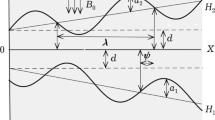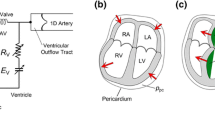Abstract
The non-Newtonian blood flow, together with magnetic particles in a stenosed artery, is studied using a magneto-hydrodynamic approach. The wall slip condition is also considered. Approximate solutions are obtained in series forms under the assumption that the Womersley frequency parameter has small values. Using an integral transform method, analytical solutions for any values of the Womersley parameter are obtained. Numerical simulations are performed using MATHCAD to study the influence of stenosis and magnetic field on the flow parameters. When entering the stenosed area, blood ve- locity increases slightly, but increases considerably and reaches its maximum value in the stenosis throat. It is concluded that the magnitude of axial velocity varies considerably when the applied magnetic field is strong. The magnitude of maximum fluid velocity is high in the case of weak magnetic fields. This is due to the Lorentz’s force that opposes motion of an electrically conducting fluid. The effect of externally transverse magnetic field is to decelerate the flow of blood. The shear stress consistently decreases in the presence of a magnetic field with increasing intensity.
Similar content being viewed by others
Abbreviations
- A 0 :
-
amplitude of pressure gradient steady (N/s3)
- B :
-
magnetic flux intensity (T)
- B 0 :
-
applied magnetic field
- b 0 :
-
amplitude of body acceleration (N/s3)
- \({\overline L _0}\) :
-
length of stenosis (m)
- A 1 :
-
amplitude of pressure gradient oscillations (N/s3)
- \(\overline R \left( {\overline z } \right)\) :
-
radius of artery in stenosed region (m)
- \(\overline R \left( 0 \right)\) :
-
radius of normal artery (m)
- E :
-
electric field intensity (V/m)
- E hydp :
-
effective hydrodynamic radius
- F em :
-
electromagnetic force (N/m3)
- F m :
-
magnetic force (N/m3)
- F b :
-
buoyancy force (N/m3)
- F blood :
-
fluidic force (N/m3)
- G:
-
\(\frac{{M\mu }}{{\rho \overline {R_0^2K} }}\) particle mass parameter
- \(\overline \varphi \) :
-
\(\left( {\frac{{{\xi _s}}}{{\overline R \left( 0 \right)\overline {L_0^m} }}} \right)\frac{{{m^{m/\left( {m - 1} \right)}}}}{{\left( {m - 1} \right)}}\) maximum height of stenosis
- H a :
-
\(\sqrt {\frac{\sigma }{\mu }} {B_0}{\overline R _0}\) Hartmann number
- J :
-
current density (A/m2)
- k :
-
unite vector of z-direction
- K :
-
Stokes constant
- L :
-
length of stenosis (m)
- m :
-
stenosis shape parameter (m ≥ 2)
- M :
-
mass of single nanoparticles (Kg)
- N :
-
number of magnetic particles per unit volume
- p :
-
pressure gradient (Pa)
- R 1 :
-
\(\frac{{KN\overline {R_0^2} }}{\mu }\) particle concentration parameter
- d :
-
stenosis location
- r :
-
radius (m)
- t :
-
time (s)
- u :
-
velocity of blood (m/s)
- v :
-
velocity field
- v :
-
velocity of magnetic particles (m/s)
- G(t):
-
body acceleration
- α2 :
-
\(\frac{{\overline {{w_p}} \overline R _0^2\rho }}{\mu }\) Womersley frequency parameter
- µ 0 :
-
magnetic permeability (H/m)
- \(\overline \tau \) :
-
shear stress
- \({\overline \tau _y}\) :
-
yield stress
- ρ:
-
density of blood (kg/m3)
- µ:
-
dynamic viscosity of blood (kg/(ms))
- σ:
-
electrical conductivity (S/m)
- \({\overline \omega _b}\) :
-
\(2\pi {\overline f _b}\) frequency (Hz)
- \({\overline f _b}\) :
-
pulse rate frequency (Hz)
- φ:
-
lead angle of body acceleration
- \({\overline \omega _p}\) :
-
\(2\pi {\overline f _b}\) heart pressure frequency
- \({\overline f _p}\) :
-
pulse rate frequency (Hz)
References
Hogan, H. A. and Henriksen, M. An evaluation of a micropolar model for blood flow through an idealized stenosis. Journal of Biomecanics, 22, 211–218 (1989)
Bali, R. and Awasthi, U. Effect of a magnetic field on the resistance to blood flow through stenotic artery. Applied Mathematics and Computation, 188, 1635–1641 (2007)
Sankar, D. S. and Lee, U. Mathematical modeling of pulsatile flow of non-Newtonian fluid in stenosed arteries. Communications in Nonlinear Science and Numerical Simulation, 14, 2971–2981 (2009)
Mustapha, N., Amin, N., Chakravarty, S., and Mandal, P. K. Unsteady magnetohydrodynamic blood flow through irregular multi-stenosed arteries. Computers in Biology and Medicine, 39, 896–906 (2009)
Pralhad, R. N. and Schultz, D. H. Modeling of arterial stenosis and its applications to blood diseases. Mathematical Biosciences, 190, 203–220 (2004)
Sahu, M. K., Sharma, S. K., and Agrawal, A. K. Study of arterial blood flow in stenosed vessel using non-Newtonian couple stress fluid model. International Journal of Dynamics of Fluids, 6 (2), 248–257 (2010)
Nagarani, P. and Sarojamma, G. Effect of body acceleration on pulsatile flow of Casson fluid through a mild stenosed artery. Korea-Australia Rheology Journal, 48, 189–196 (2008)
Yadav, S. S. and Kumar, K. Bingham plastic characteristic of blood flow through a generalized atherosclerotic artery with multiple stenosis. Advance in Applied Scicience Research, 3, 3551–3557 (2012)
Srikanth, D. and Tedesse, K. Mathematical analysis of non-Newtonian fluid flow through multiple stenotic artery in the presence of catheter—a pulsatile flow. International Journal of Nonlinear Science, 13, 15–27 (2012)
Siddiqui, S. U., Shah, S. R., and Geeta. A A biomechanical approach to study the effect of body acceleration and slip velocity through stenotic artery. Applied Mathematics and Computation, 261, 148–155 (2015)
Voltairas, P. A., Fotiadis, D. I., and Michalis, L. K. Hydrodynamics of magnetic drug targeting. Journal of Biomecanics, 35, 813–821 (2002)
Ganguly, R., Gaind, A. P., Sen, S., and Puri, I. K. Analyzing ferrofluid transport for magnetic drug targeting. Journal of Magnetism and Magnetic Materials, 289, 331–334 (2005)
Banerjee, M. K., Datta, A., and Ganguly, R. Magnetic drug targeting in partly occluded blood vessels using magnetic microspheres. Journal of Nanotechnology in Engineering and Medecine, 1, 1–9 (2010)
Furlani, E. P. and Ng, K.C. Analytical model of magnetic nanoparticle transport and capture in the microvasculature. Physics Review E, 73, 061919 (2006)
Furlani, E. J. and Furlani, E. P. A model for predicting magnetic targeting of multifunctional particles in the microvasculature. Journal of Magnetism and Magnetic Materials, 312, 187–193 (2007)
Sharma, S., Katiyar, V. K., and Singh, U. Mathematical modelling for trajectories of magnetic nanoparticles in a blood vessel under magnetic field. Journal of Magnetism and Magnetic Materials, 379, 102–107 (2015)
Sharma, S., Singh, U., and Katiyar, V. K. Magnetic field effect on flow parameters of blood along with magnetic particles in a cylindrical tube. Journal of Magnetism and Magnetic Materials, 377, 395–401 (2015)
Nehad, A. S., Dumitru, V., and Constantin, F. Effects of the fractional order and magnetic field on the blood flow in cylindrical domains. Journal of Magnetism and Magnetic Materials, 409, 10–19 (2016)
Gayathri, K. and Shailendhra, K. Pulsatile blood flow in large arteries: comparative study of Burton’s and McDonald’s models. Applied Mathematics and Mechanics (English Edition), 35, 574–590 (2014) DOI 10.1007/s10483-014-1814-7
Hatami, M., Ghasemi, S. E., Sahebi, S. A. R., Mosayebidorcheh, S., Ganji, D. D., and Hatami, J. Investigation of third-grade non-Newtonian blood flow in arteries under periodic body acceleration using multi-step differential transformation method. Applied Mathematics and Mechanics (English Edition), 36, 1449–1458 (2015) DOI 10.1007/s10483-015-1995-7
Bennett, L. Red cell slip at a wall in vitro. Science, 24, 1554–1556 (1967)
Ponalagusamy, R. Blood flow through an artery with mild stenosis: a twolayered model, different shapes of stenoses and slip velocity at the wall. Journal of Applied Sciences, 7, 1071–1077 (2007)
Zaman, A., Ali, N., and Sajid, M. Slip effects on unsteady non-Newtonian blood flow through an inclined catheterized overlapping stenoric artery. AIP Advances, 6, 015118 (2016)
Reddy, J. R., Srikanth, D., and Murthy, S. K. Mathematical modelling of pulsatile flow of blood through catheterized unsymmetric stenosed artery-effects of tapering angle and slip velocity. European Journal of Mechanics B/Fluids, 48, 236–244 (2014)
Nadeem, S. and Ijaz, S. Theoretical examination of nanoparticles as a drug carrier with slip effects on the wall of stenosed arteries. International Journal of Heat and Mass Transfer, 48, 1137–1149 (2016)
Johnson, M., and Ethier, C. R. Problems for Biomedical Fluid Mechanics and Transport Phenomena, Cambridge University Press, Cambridge (2013)
Ahmed, S. Bingham plastic fluid model for steady flow of blood with velocity slip tube wall in presence of magnetic field. Asian Journal of Technology & Management Research, 5(1), 57–70 (2015)
Sharma, S., Kumar, R., and Gaur, A. A model for magnetic nanoparticles transport in a channel for targeted drug delivery. Procedia Materials Science, 10, 44–49 (2015)
Acknowledgements
Authors are grateful to reviewers for their observations and suggestions that led to the paper improvement. The first author is grateful to Abdus Salam School of Mathematical Sciences, Lahore for support in the scientific research.
Author information
Authors and Affiliations
Corresponding author
Additional information
Project supported by the Tertiary Education Trust Fund of Nigeria (TETFund) (No. FPTB-2016)
Rights and permissions
About this article
Cite this article
Mirza, I.A., Abdulhameed, M. & Shafie, S. Magnetohydrodynamic approach of non-Newtonian blood flow with magnetic particles in stenosed artery. Appl. Math. Mech.-Engl. Ed. 38, 379–392 (2017). https://doi.org/10.1007/s10483-017-2172-7
Received:
Revised:
Published:
Issue Date:
DOI: https://doi.org/10.1007/s10483-017-2172-7




